Cycas revoluta
For an impressive dose of prehistoric drama, consider sago palm.
The Cycad genus in the Cycadaceae family includes over 100 species, with the most common being Cycas revoluta or the king sago, the main focus of this article.
Like ferns, these giant beauties have been around since before the dinosaurs, and their stunning display is truly evocative of an age long gone.
In fact, they’re sometimes referred to as “living fossils,” dating back to the early Mesozoic Era without much change since then.

We link to vendors to help you find relevant products. If you buy from one of our links, we may earn a commission.
Dark green and lush with sturdy foliage, if you live in a warm climate zone or you’re looking for a new addition to your indoor garden, this plant is for you.
Here’s what’s to come in this article:
Growing Sago Palm
Let’s learn more!
Cultivation and History
While “palm” is part of their common name, sago palms are not really palm trees at all. They’re cycads, a group of seed plants with ancient roots related to cone-bearing conifers.
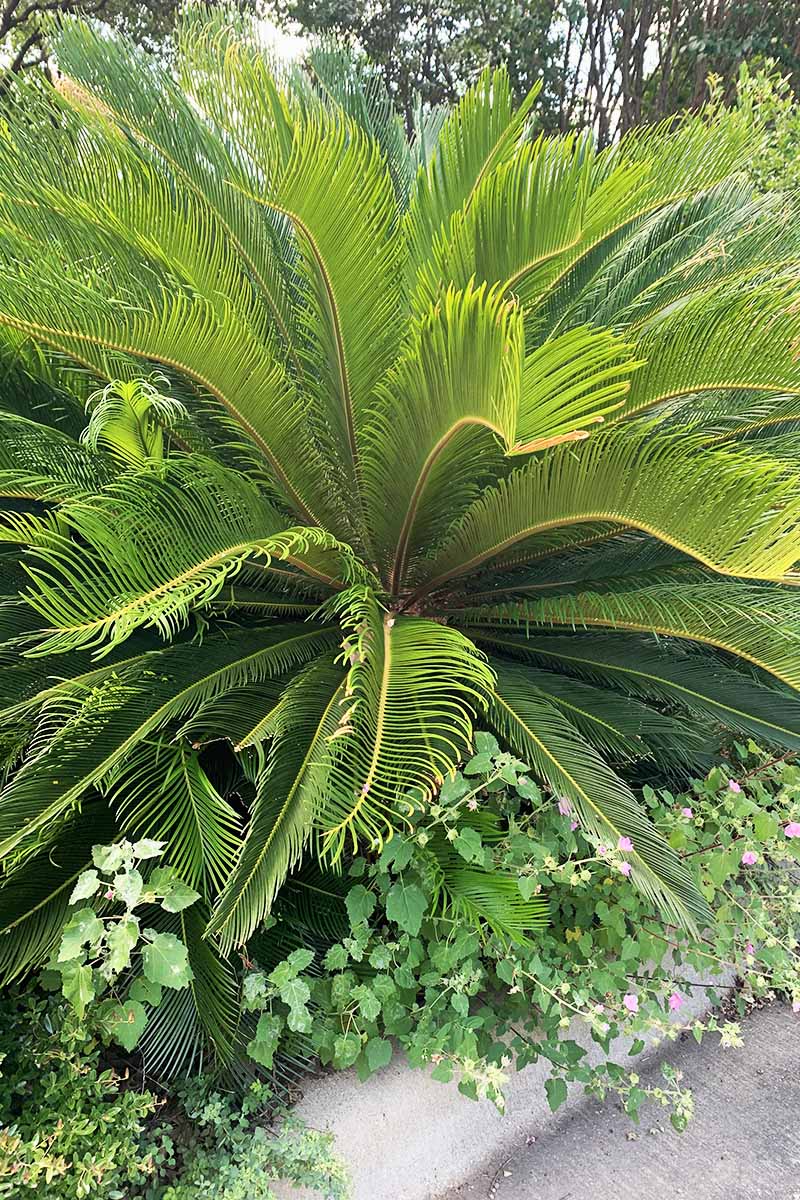
Other names for this type of sago palm include king sago, palm cycad, or Japanese funeral palm.
Native to the southernmost island of Japan, the leaves were traditionally used in funeral arrangements in the Land of the Rising Sun.
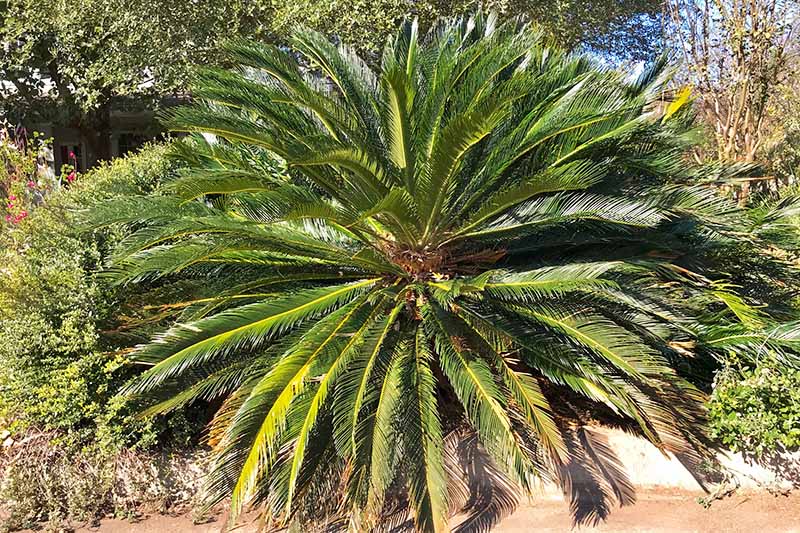
C. circinalis, or queen sago, is another common species that is native to India. It’s commonly grown in parts of Asia and Hawaii.
This is not to be confused with C. micronesica, another species that is found in Micronesia, Palau, and Guam. This species gained notoriety when it was found to be linked to Lytico-Bodig disease, which is similar to ALS.
The seeds of C. micronesica were a traditional food source on Guam until the 1960s, but they contain a potentially dangerous neurotoxin and should not be consumed.
I repeat – do not eat any part of your cycads, they contain a toxin called cycasin that can cause liver failure in humans and animals. They are ornamentals only!
Sago grows slowly when confined to a pot, and it is also a favorite choice for bonsai.
Gardeners located within or north of USDA Hardiness Zone 8a must grow these ancient wonders in pots and bring them indoors to overwinter, but those of us in Zones 8a to 11b get to enjoy them in our landscapes year-round.
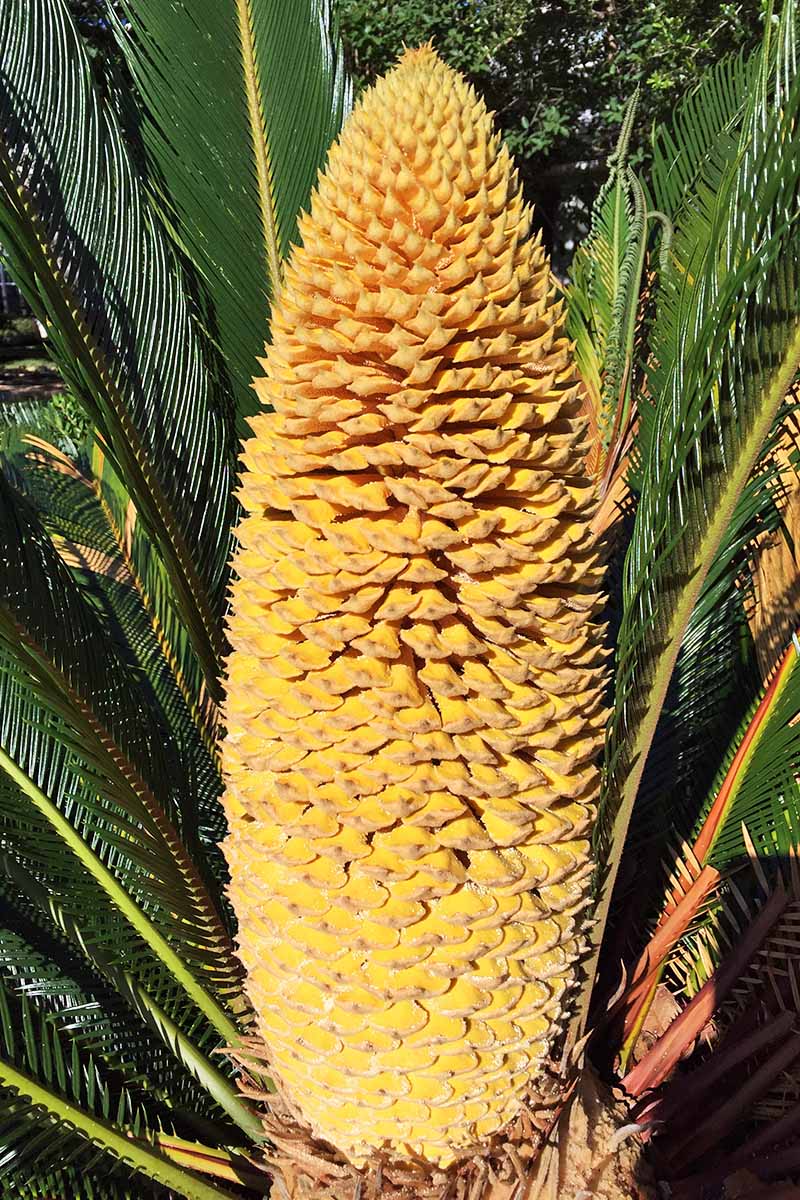
When grown outdoors, C. revoluta may reach a height of 10 to 12 feet, though the ones I see in Austin are closer to about five feet tall.
Here they are also typically allowed to fall into a spreading, half-round form, rather than the more upright, palm tree-like form that results when the lower fronds are trimmed off.
The pinnate leaves are typically about four to five feet long at maturity, reaching their greatest length when grown in partial shade. Shiny, new leaves sprout from the top of the crown in a circular pattern, located above a woody trunk.
As mentioned above, sago palms are poisonous to humans and pets, something to keep in mind if you have a dog who likes to experiment with new cuisines.
Our dogs have never bothered our sagos, and the spiky leaf tips act as a deterrent as well.

Each sago palm is either male or female. In late spring, males may produce a 12- to 24-inch-tall cone, whereas females produce a leaf structure resembling a basket that produces ovules.
The “basket” opens when the plant is ready to be fertilized by pollen from the male, carried by wind or insects.
Keep in mind that sago palms may take over a decade to reach maturity and bloom for the first time. This will only happen under ideal growing conditions, every three years or so.
Propagation
C. revoluta can be propagated via division, as well as growing by seed.
Division
For the first method, you may notice new clusters forming near the base of the plant. These pups can be cut off and planted elsewhere, or shared with fellow gardeners.
Don’t procrastinate if you are going to attempt this process. Once the pups get too large, it’s very difficult to successfully propagate them. Get them before they’re a foot tall.
In the spring or fall, clear the dirt from around the base of each pup. Grasp the base of a pup and gently wiggle it to pop it off. If it has already grown too large, you may have to cut it off with a clean, sharp gardening knife.
Pinch or cut off any leaves that are sprouting from the pup. Place separated pups in the shade for a week to heal the wound, then choose a pot that’s a couple inches larger in diameter than the pup.
Fill the pot with a fast-draining blend of sand, perlite, and peat moss, or a container mix that’s suitable for palms. Dig a hole and place the pup in the hole with the wound side down.
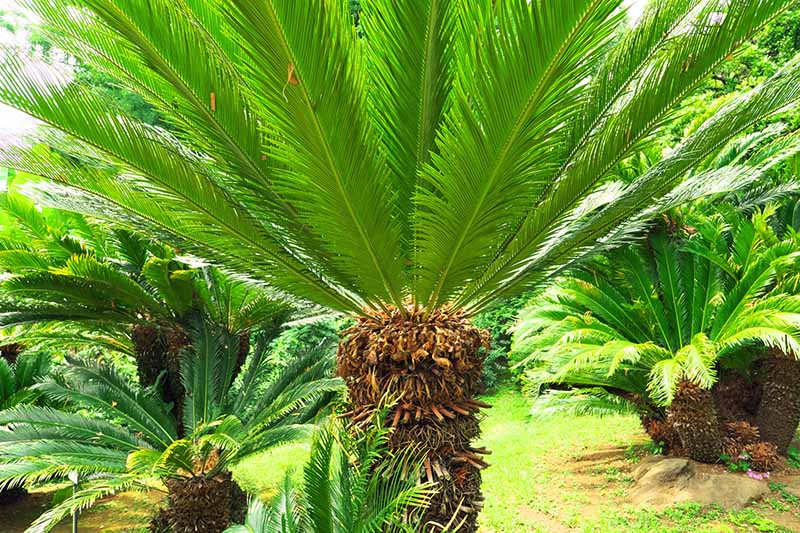
Water thoroughly, and let the soil dry out before watering again. Keep in the shade and away from bright sunlight until it has rooted, and note that this can take several months.
Seed
You can also propagate these ancient beauties from seed.
In a small pot, press the seed into the soil with the flat side up, keeping about one-third of the seed above soil level, and place the pot in a warm area.
Plant one seed per pot, to give it room to grow.
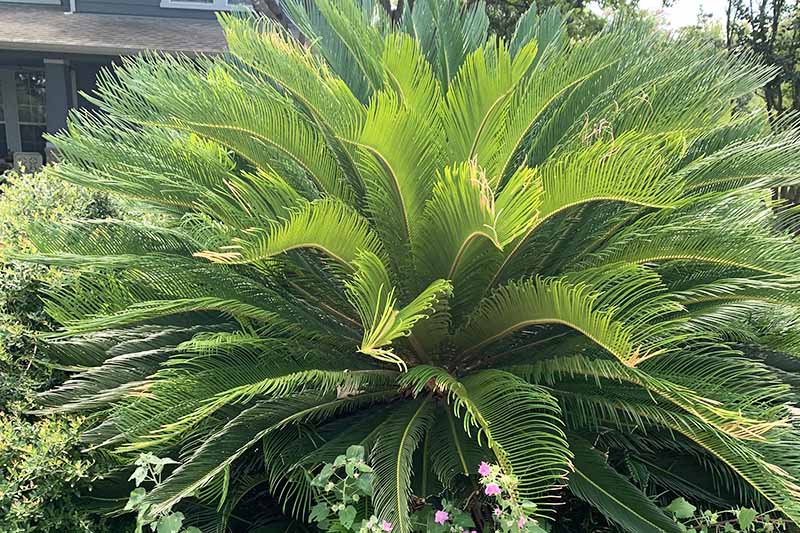
Tamp the soil down around the seed, water well, and cover the pot with plastic to create a mini greenhouse that locks in warmth and moisture.
Sago seeds will germinate in temperatures of 70 to 100°F, so leave them in a warm, sunny location or use a heat mat.
Be patient – they can take up to three months to germinate. Keep the soil moist, and when the seed germinates, you can remove the plastic wrap.
If you live in a hospitable area, you can plant the palms in the ground in early spring or late fall, after about three years once a strong root system has had time to develop.
Otherwise, repot into successively larger containers as your cycad grows larger. Small specimens are perfect for bonsai!

To save your own seeds – or if you have a neighbor with mature female sagos – wait until fall to harvest them when the fruit is ripe.
Wearing gloves, collect the orange fruit. You can tell the viable seeds from the unfertilized ones by placing them in a bucket of water; save the seeds that sink and discard the rest.
Collected seeds can be stored at room temperature in an airtight bag or container. Before planting, allow them to soak in water overnight to soften their outer coating. Rinse well before potting up.
How to Grow
C. revoluta can tolerate full sun, and will do well in partially shaded areas in particularly hot and dry climates, where it will likely produce longer leaves. Bright light is required for growing indoors.
Leaf damage due to both extreme heat and sun or extreme cold can cause damage to your cycads, leaving them susceptible to disease.
When in doubt, give them some shade and protection. And don’t crowd your sagos in with other plants, to promote good airflow.
They aren’t picky about soil. Mine have thrived in average, non-amended garden soil for years. For healthy, vibrant sagos, well-draining sandy soil is best.

Outdoor sagos are fairly drought-tolerant, and can go weeks without supplemental water and work great for xeriscaping in warm, dry climates.
In fact, you should allow your plants to dry out between watering, plant only in well-draining pots, and avoid overwatering whenever possible.
Sago palms don’t like wet feet, and a well-intentioned watering-happy gardener can unwittingly cause their plants to become susceptible to disease.
No supplemental fertilizer is typically needed either. I’ve found that mine grow well in the native soil, with no need for amending of any kind.
Once a month during the growing season, an 18-8-18 water-soluble fertilizer may be applied to keep your sagos at their best, at a rate of one teaspoon per gallon of water, or according to package directions.
Regular applications of fertilizer will help to encourage C. revoluta to bloom, and produce new growth. Palm or citrus fertilizer may be used effectively on cycads as well.
Growing Tips
- Plant in well-draining, sandy soil
- Drought tolerant, requiring infrequent watering
- Supplement with fertilizer once a month, except when dormant
- Bring container plants indoors for the winter in hardiness zones 8a and lower
Pruning and Maintenance
Evergreen C. revoluta requires little maintenance.
Here in Austin, my sagos have suffered leaf burn during a couple of winters when temperatures sank into the low 20s for one or two nights, but otherwise, they overwinter in my growing zone perfectly well.
Established plants grown outdoors may be covered with burlap for protection in rare cases of extreme winter weather.
Dead fronds can be removed with sanitized pruners. Remember to wear gardening gloves when you are doing this, to avoid jabs from the sharp, pointed leaf tips.
To improve the look of the plant, you may also choose to carefully cut away withered fruit and flower stalks at the end of the season, for seed saving or disposal.
Keep in mind that pruning is only recommended for brown, dry fronds that have died. You may be tempted to remove yellowing fronds, particularly if you feel they ruin the green, lush appearance. Here’s what I have to say to that: don’t!
Removal of these fronds, especially when yellow portions are found towards the bottom of the plant, can actually cause stress. And this can lead to stunted growth, or make your plants susceptible to infection.
Yellow fronds are still alive and absorbing nutrients, and removal may actually cause the problem to spread up the plant in cases where this is a sign of disease.
See the section below on managing pests and diseases for additional suggestions and information.
Over the years, as your sago palm matures, you may choose to prune it into a tree form rather than a rounded bush with lower leaves that touch the ground.
This must be done gradually over the course of years, in order to avoid undue stress. Remove the oldest fronds from the base sparingly, cutting as closely to the trunk as possible.
Plant and Seed Selection
Ready to get growing?

If you don’t have a local retail source available, or a friendly neighbor who saved some fruit or pups for you, you still have options.
You can find C. revoluta seeds available in packages of 55 from Dichondra via Amazon.

King Sago Palm 6-Inch Live Plant, 1-Gallon Pot
If you’re looking for a more mature live specimen, six-inch plants in gallon pots are available from American Plant Exchange via Amazon.
Sago Palm 8- to 12-Inch Live Plant, 3-Gallon Pot
And if you want an ever larger specimen, you can find live plants in three-gallon pots available from Fast Growing Trees.
Managing Pests and Disease
Sagos are pretty hardy, and they should do well in your garden with proper care if planted in a suitable location.
A few potential pests and problems that you may encounter include scale insects, yellowing, sooty mold, and various types of rot.
If you’ve ever had aphids take over your rose bushes, you’re probably familiar with the honeydew that they excrete, and the unsightly mold that can grow on your plants as a result. Scale bugs can cause similar issues when they attack your cycads.
They might be poisonous to humans and pets, but certain species of these insects love them!
We cover this problem and more in our guide on sago palm pests and diseases that might affect them, with preventive measures that you can take to protect your garden and suggested techniques for control, including the use of beneficial insects and integrative pest management techniques.
Best Uses
In addition to serving as a gorgeous ornamental that remains green throughout the year both indoors and out, I’ve found a decorative use for those aging portions of my C. revoluta as well.
I just cut out the “burned,” dry brown fronds and place them decoratively in a large planter on my porch. The original plant is fine, and I have the added bonus of a nice dried arrangement.
The dried fronds are fairly “pokey” though, so displays should be placed in a low-traffic area. And do not used diseased portions of plants for decoration, as any fungal growth or insects present may spread to other parts of the garden. Dispose of these appropriately.
Remember: No portions of the sago palm may be eaten. If you’re looking for an edible option for the backyard with unusual fruit, maybe the loquat is for you.
Quick Reference Growing Chart
| Plant Type: | Cycads, evergreen, shrub, houseplant | Foliage Color: | Emerald green |
| Native to: | Southern Japan | Growth Rate: | Slow |
| Hardiness (USDA Zone): | 8a-11b | Maintenance: | Low |
| Season: | Evergreen | Soil Type: | Sandy or silt loam |
| Exposure: | Full to partial sun | Soil pH: | 5.5-6.5 |
| Time to Maturity: | 10 years+ | Soil Drainage: | Well-draining |
| Spacing: | 3 feet minimum | Companion Planting: | Bulbine plants, red yucca, palms, succulents |
| Planting Depth: | For potted, same as nursery pot | Uses: | Ornamental, dried arrangements |
| Height: | Typically 5 feet, up to 10-12 | Attracts: | Pollinators |
| Spread: | Up to 8 feet, fronds 4-5 feet | Order: | Cycadales |
| Water Needs: | Low to moderate | Family: | Cycadaceae |
| Tolerance: | Drought | Genus: | Cycas |
| Pests & Diseases: | Aphids, scale bugs, thrips, mealybugs, sooty mold, root rot, pink rot | Species: | revoluta |
Where Will You Plant Yours?
While C. revoluta makes a spectacular landscape plant for those of us in the southern United States, gardeners in other parts of the country can enjoy these prehistoric wonders indoors.

Sun or shade, good dirt or bad, this dramatic palm-like plant loves hot climates and rewards with a singular display.
Have you ever grown sago palm? Indoors or out? Share your experience in the comments section below.
Are you looking for more drought tolerant perennials? Some of these guides might be right up your alley:
Photos © Ralph Barrera reprinted with permission. Photos by Gretchen Heber © Ask the Experts, LLC. ALL RIGHTS RESERVED. See our TOS for more details. Product images via Serendipityseed, American Plant Exchange, and 9Greenbox. Uncredited photos: Shutterstock. Originally published on December 2, 2017. Last updated on June 29, 2019. With additional writing and editing by Allison Sidhu.
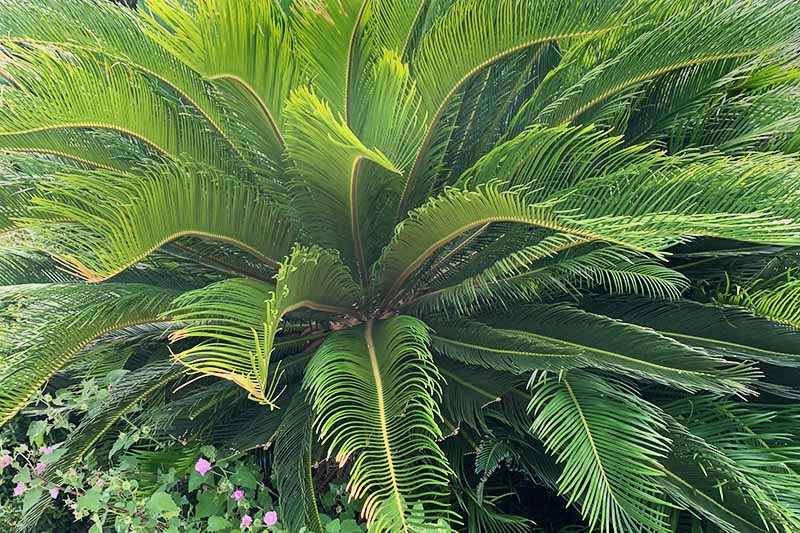
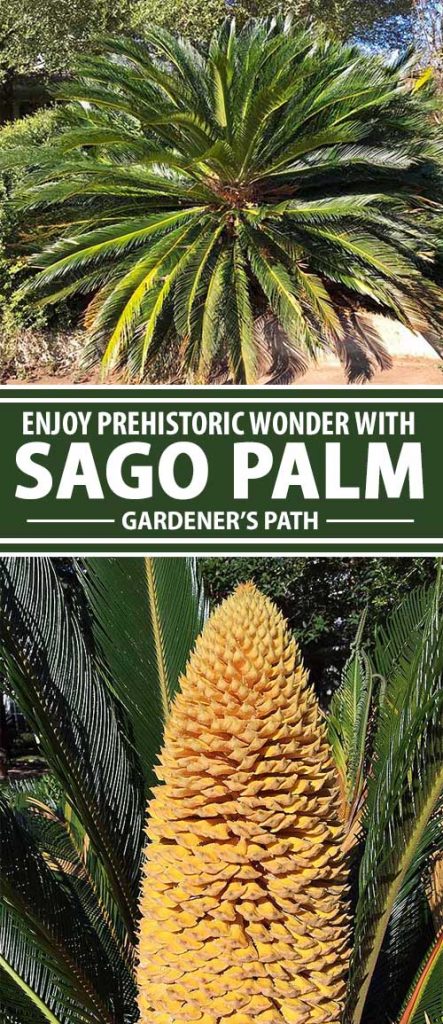
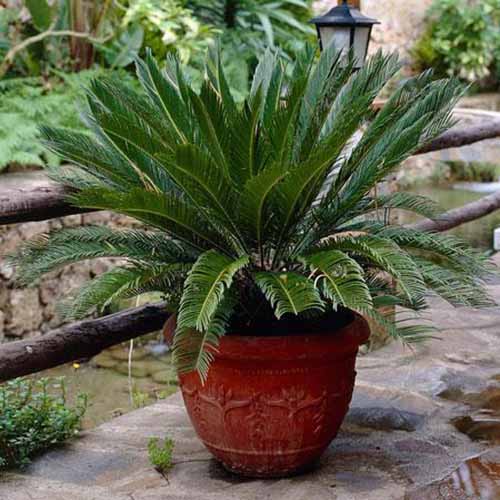


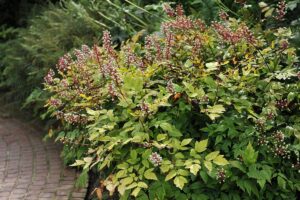
I believe your comment on Sago being poison to humans and dogs is somewhat misleading. The seeds are what is poison and all you need to do is remove them. I must do this with my queen palms also. Well actually my son does that job.
Hi Linda, Thanks so much for reading our article! In terms of sago’s toxicity, we consulted multiple reputable sources, all of which confirm the plant is poisonous. UC Davis, for example, says, “… all parts of the plant are poisonous. The plants contain the chemical compounds cycasin and B-methylamino-l-alanine, which are toxic to the nervous system when ingested.” When I trim my sago, even if I wear long sleeves, I come away with extremely irritated skin that can last for days, presumably a result of my body not liking the plant’s chemicals. The university does back up your assertion that… Read more »
You are absolutely correct, a friend’s dog died yesterday after a week in emergency vet. Entire sago palm is poisonous and did fatal liver damage to her pup. The sago is deadly, but the queen palm seeds will cause stomach upset, no death. We have had both these palms for decades. I do have another question: my daughter’s gardener removed all the fronds I believe in error, just leaving the round growth – I believe is a seed pod. Did he kill the plant and should I go ahead and remove the pod and see if it develops more frond… Read more »
I’m so sorry to hear about your friend’s dog, Linda. Were the fronds that were removed dying, yellow, or damaged? At this point, I would refrain from doing any more pruning until the plant has had some time to recover. As for the central round growth, from your description this sounds like it could be a female cone. Feel free to upload photos for identification. For the health of the plant, you should typically wait to remove any cones until they have finished their reproductive cycle and dried out fully. With a little luck (and proper care!), new growth should… Read more »
Find another gardner — quickly!
Nice informative article Gretchen. I just dug up 36 pups from male plants and 30 pups from female plants. My question is, will all the pups from the male plant be male and all the pups from the female be female? When I plant a female, should I plant a male close by? Thanks for the great information.
Thank you, Gary. It is my understanding that both genders can produce both genders. If you want your female plant to produce fertilized (viable) seeds, you’ll need to have a male nearby.
Our sago – 25 years old and 8 1/2 to 9 ft tall – now sadly damaged by 2 wks of frost and ice – all the fronds from top to base are gone but trunk seems still hardy. Going to sheer trunk down and wait to see if it will regrow and blossom with previous both male and female flowers. It was our pride and joy and hope it will regenerate before we no longer on this beautiful earth. Stay safe.
Hi there, What a rough time you all have gone through – and the plants too! I’m sorry to hear about the damage to your sago palm – and so many others like yours. You may want to hold off on your plans to prune your sago. Texas master gardeners are recommending to wait a couple of weeks before pruning to give sago palms some time to recover. Then inspect the top of the trunk (in your case, with the help of a ladder) for signs of new growth – your tree may be able to produce new fronds, especially… Read more »
Mines did the same but I removed all the brown and gave it lots of attention and last month it came back.
When you measure the height of the sago, do you measure trunk only, or do you include the uppermost frond length as well?
How does one know if the Sago is male or female?
Hello Rocky. The males produce those golden cones. M. Winston Ngwenya has thoughtfully provided a photo in the following comment.
The male is just near
Thanks so much for the photo of a male with one of the cones they produce on full display, M. Winston Ngwenya. It’s always good to see a thriving sago palm.
My sago plum has started blooming new branches 3 times and then died off. The new ones come out and grow larger then the older branches then die off. I have two older ones and two new ones coming up. What can I do so they do not die off. What should I do and what part sand and dirt do I mix.
Your plants could be suffering from a manganese sulfate deficiency. You can purchase manganese sulfate supplement at garden centers. Be sure to avoid confusion with magnesium sulfate! Or, your plants could have cyad scale. You can learn more about identifying and treating scale here.
I have a large 7 foot male sago (no seeds, thank goodness as my friend’s puppy ate a female sago seed in her yard and died in 24 hours). My plant is growing very well in direct sunlight in San Antonio. So much so I have to trim the leaves and the pups regularly. I’ve learned the trick on trimming the leaves. While the leaves are green and lush you can grab them and pull downward against the way they are growing and most of the time they break off right next to the trunk. Always grab the leave about… Read more »
JHSATX, thanks so much for your excellent tip! I wear long sleeves, too, when I’m working with this plant, as it irritates my skin so.
Oh, and I’m terribly sorry about your friend’s pooch; how very sad.
I have 2 sago palms in my yard. I planted them in 2007. It turns out one palm is a male and one is a female as both have matured this summer. It’s quite a display. They are easy to grow and maintain. I’ve planted a couple of pups as well. This article was very helpful. Thank you for confirming my suspicions (male / female).
Lucky you, Yolo, to have gotten one of each gender. They do indeed display their gender quite strikingly!
Hi – I’ve bought many (smaller) sagos in pots and they seem fine until watered – even after 2-3 mos – at which time they go yellow/brown and possibly die, no matter how much or little water I give them, though they’re in very bright light (and supplemented/fluors in winter – I’m in Canada). Don’t know what to do… or are they only sold here as temporary decor and not expected to live long? I don’t feed them. Thank you so much!
Hi Cat! Sounds very frustrating! Overwatering sagos can cause them to turn yellow. They can also go yellow from lack of light or lack of nitrogen. Sounds like you’re taking care of water and light, so maybe feed them some nitrogen?
Ours is very large, about 5 ft, and growing very crooked. Question, can we cut it off at the bottom and let us start over?? If not, how long are the roots if we need to remove it?
I’d be worried about cutting it all off. I think I’d just enjoy the crookedness or move it, and while this can be quite a process, it is quite doable.
Hi Emergency room veterinarian here, just wanted to clarify the toxicity to dogs. Eating sago palm can cause fatal liver failure in dogs. It’s fine to have them just be absolutely sure to restrict dogs access to them. Not worth the risk in opinion. Hope that’s helpful
Thank you, Dr. William, for weighing in with your expertise! How lucky we are to have such a diverse readership. My sagos are well away from sweet Lacey here.
Thank you. We have 12 in our back yard. 2 of them are 50 years old, they have multiple trunks and are beautiful. We have dogs and are very careful when we prune the Palms. I’ve always heard they are deadly for dogs. We’ve had 9 dogs thru the years and never had a problem. Thank you for the great article about these beautiful plants. I truly enjoyed reading it all and the comments!!
I am wondering why my Sago doesn’t have dark green palms. Also I don’t see new growth. I’ve sprayed with fungicide with did make the palms look better. They had black and white growth on them. I also cut off a couple of large pups. Some small pups have grown back since. See the picture. Can I get some advice how to proceed?
Hi Randy! What strikes me as odd about your sago is how floppy the leaves are. Mine are more upright. Is yours a female? Have you had your soil tested? I wonder if there’s a nutrient deficiency. Also, do you know if that area drains well?
Hi, I had a huge indoor Sago Palm for many years. It died and my son bought me a small one at Lowes. It is planted in pebbles in what feels like solid concrete on top. Should I re-pot it ? Or just keep it as it for now. I am not sure how to water it this way. I have not watered it yet. I know to let it get dry. I have two huge Sea Grape plants I started from seed. I did not know they would live indoors. They are indoors most of the year. I just… Read more »
Hi Suzan! What a sweet son you have! And it sounds like you have quite the indoor-gardening green thumb. I think I would repot the sago. Sounds kind of crazy… a concrete topper?
I have a Sago palm that is always in the house. It sits on a stand in a south window getting plenty of sunshine. Does very well there. Recently it sprouted to very tall stems growing from the middle of the bulb. The leaves were curled so tight. Now they have opened all
The way. So beautiful, but so big. The rest of the leaves are just as they were when I purchased it 3-4 yrs ago. Do I prune these new stems or what? I am baffled.
Hi Marsha! Thanks for reading my article. I’m wondering if it’s not creating new leaves because its root-bound? No need to prune any leaves unless they are dead.